Working-class heroes: Understanding labour market data
Working-class heroes: Understanding labour market data – Media release
19 December 2018
Recent strong labour market data has sparked questions, which we answer here, about how we define and measure employment, unemployment, and underutilisation Stats NZ said today.
As first reported on 7 November 2018, unemployment is at a 10-year low of 3.9 percent, while the employment rate is the highest on record, going back more than 30 years.
Delving deeper into the Household Labour Force Survey (HLFS), the data shows that a little over 1 in 6 employed people work 50 hours or more a week, while the vast majority work 30 hours or more. At the same time, fewer than 1 in 50 employed people work fewer than five hours a week.
See how we measure some of our key labour market
data, and why our customers can be confident in the accuracy
of this data:
• How we measure key labour market
data
• How we define employment
• How we define unemployment
• Sampling errors – an expected part of any
survey
• New and important labour market data –
underutilisation
How we measure key labour market data
Every three months, Stats NZ publishes labour market statistics, which include the number of people who are: employed, unemployed, not in the labour force, and, more recently, underutilised. This key data is largely produced from the HLFS.
The HLFS is a sample survey of about 15,000 households – this means roughly 30,000 people are interviewed throughout New Zealand every three months. Almost anyone in New Zealand aged 15 years and over can be selected to take part in the HLFS. Once selected, they remain in the survey for two-years. This aspect of the survey ensures consistent and accurate measurement of labour market trends in New Zealand over time. The HLFS follows best practice and required standards set by the International Labour Organization. This allows us to see how New Zealand is progressing internationally. The information we collect from the HLFS is published as part of the Labour market statistics release on the first Wednesday of February, May, August, and November.
If you are wondering how we measure key labour market data, such as employment and unemployment, you are not alone. This is what happens.
Firstly, we estimate the size of the working-age population of New Zealand – this is the non-institutionalised (eg people not in prison or rest homes) resident population of New Zealand aged 15 years and over. Then, using information collected in the survey, we work out how New Zealanders participate in the labour market and the nature of their work.
Broadly speaking, New Zealand’s working-age population is made up of two main categories of people – those who are in the labour force, and those who are not in the labour force, see figure 1.

Text alternative for figure 1, Working-age population summary, September 2018 quarter, seasonally adjusted
There are many reasons why a person might be categorised as not in the labour force, including retirement, study, or being permanently unable to work due to a disability.
In the September 2018 quarter, of those who were classified as ‘not in the labour force’ and who didn’t want a job, the top three reasons for not wanting to work were ‘retired’, ‘study or training’, and ‘own sickness/illness/injury/disability’, see figure 2.
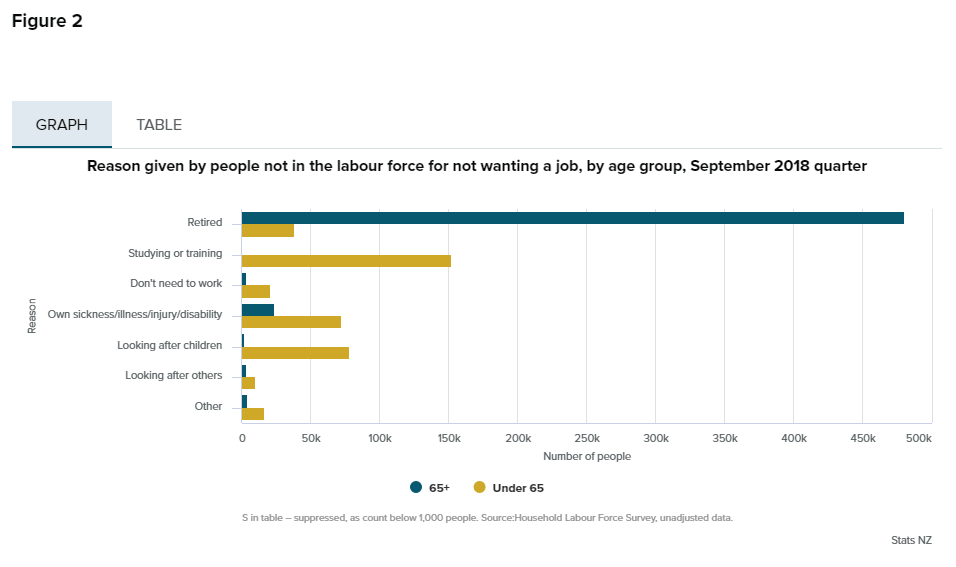
The other component of the working-age population are those people who are part of the labour force. People in the labour force are broadly categorised into two main groups – employed and unemployed, see figure 3.
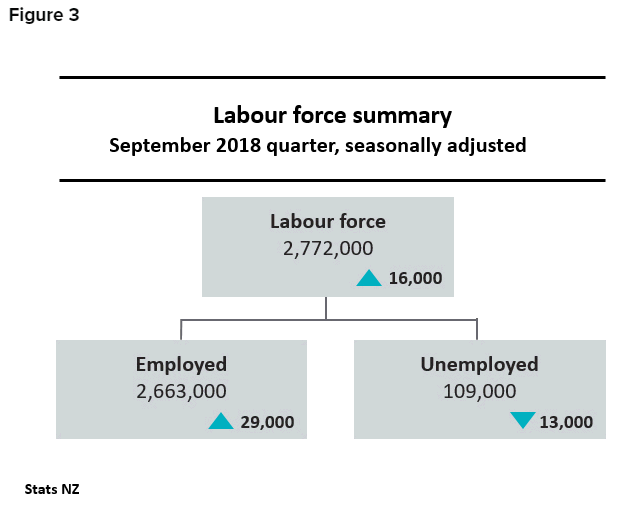
Text alternative for figure 3, Labour force summary, September 2018 quarter, seasonally adjusted
How we define employment
First, let’s look at people who are in employment. Stats NZ is often asked how we count the number of people who are employed.
Quite simply, a person is classified as employed if, during the week, they did one of the following:
• worked in a paid job for an
employer, or in self-employment
• worked in an unpaid
job, which contributed to a farm, business, or professional
practice owned by a family member
• had a job, but were
not at work due to illness or injury, personal or family
responsibilities, bad weather, mechanical breakdown, direct
involvement in an industrial dispute, or leave or
holiday.
We also ask employed people how many hours they usually work in a week. This is important, as it can show whether our employment figures are being inflated by lots of people who usually only work a few hours a week.
Figure 4 shows the proportion of employed people broken down by hours usually worked in a week.
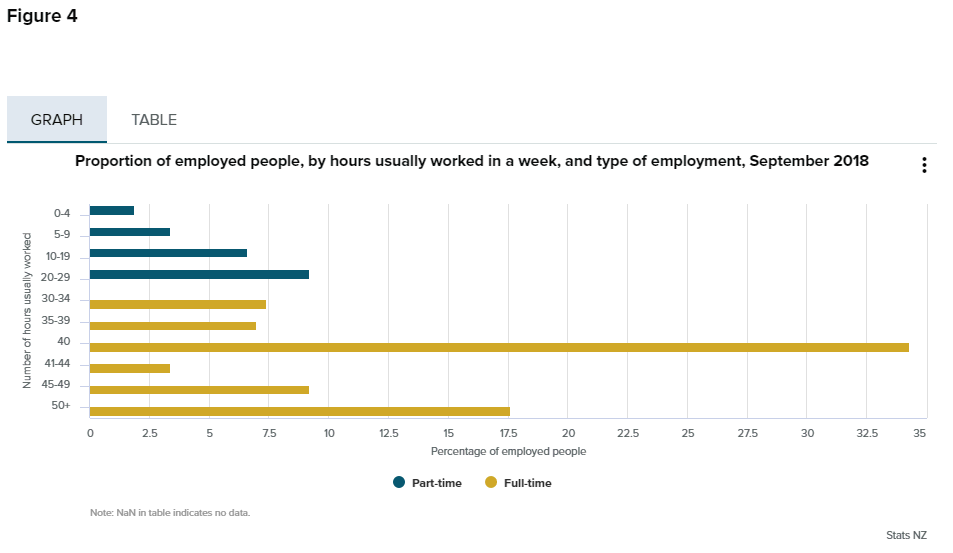
In the September 2018 quarter, the largest group of employed people in New Zealand worked a classic 40-hour week. Over three-quarters of employed people in New Zealand worked full-time (30 or more hours a week). This is just over 2 million, out of the 2.65 million people employed in New Zealand. In fact, the share of employed people in New Zealand who worked very few hours a week is low – about 49,000 employed people worked less than five hours a week in New Zealand. This equates to less than two percent of employed people in New Zealand.
How we define unemployment
The other group in the labour force are the unemployed. People are often unsure about how we define unemployment. There is sometimes a misconception that you must be receiving a benefit to be classed as unemployed, but this is not the case. To be categorised as unemployed in New Zealand, a person must:
• not have a paid job
• be available to start
work
• have been actively seeking work in the last four
weeks or be due to start a new job in the next four
weeks.
Actively seeking means they go beyond browsing job vacancies in the local newspaper or on the internet. It means a person is taking action and applying for jobs or contacting employers.
The unemployment rate is often the labour market measure that grabs the headlines. This was especially true for the three months to 30 September 2018, when the unadjusted unemployment rate fell by more than it was expected to – down to 3.8 percent, from 4.2 percent in the June quarter.
Sampling errors – an expected part of any survey
As with any sample survey, we are estimating something about a very large population from a smaller sample. Because we haven’t spoken to every single person in New Zealand, there is a small amount of expected uncertainty in our estimates. Generally speaking, the more people we survey, the smaller the degree of uncertainty is. As the HLFS is such a large survey, the sampling errors are relatively small. However, when looking at smaller sub-groups of society, such as breakdowns by some ethnicities, the sampling errors increase. To help our customers understand this, we publish the associated sampling errors of our unadjusted estimates with each release.
Sampling errors are a normal part of any survey, and they do not mean that the numbers are wrong. We are highly confident (95 percent certain) that the true value lies close to the figure we reported – plus or minus the sampling error. In other words, using the sampling errors, you can work out two numbers, between which we are 95 percent certain the true value lies. We call these two numbers the 95 percent confidence interval.
The following table shows how we calculate the confidence interval of an estimate, using its associated sampling error.
Confidence intervals are often displayed on
graphs. Figure 5 and 6 use the same data to illustrate two
different ways of displaying confidence intervals.
In figure 5, the confidence intervals are displayed by the light yellow shaded area around the blue line. We are 95 percent certain that the true value of the unadjusted unemployment rate lies within the shaded area.
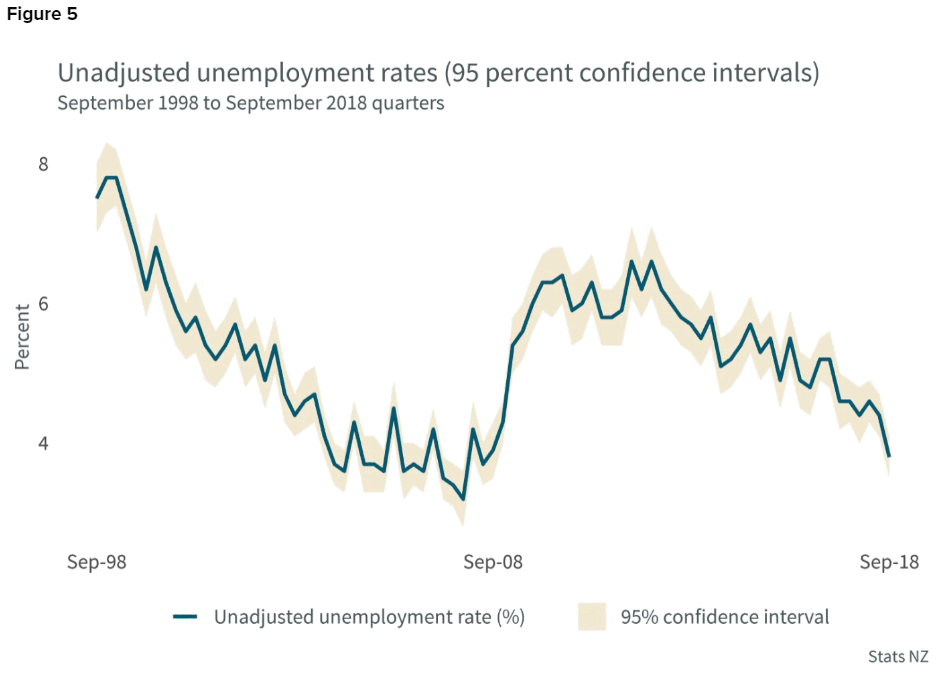
Figure 6 shows how confidence intervals are displayed using error bars. The brown bars indicate the 95 percent confidence interval for the unadjusted unemployment rates in each quarter over the last 20 years. We are 95 percent confident that the true value lies within the range of the brown bars.
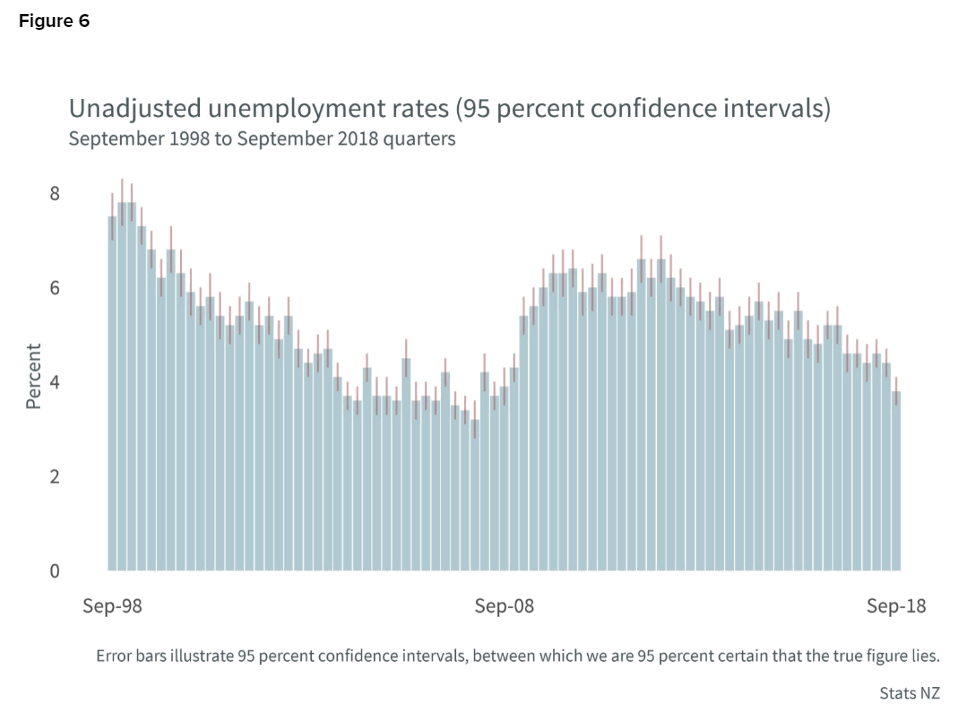
New and important labour market data – underutilisation
Over the last few years, labour market experts have begun to realise that when looking at people in the labour market, it’s not as black and white as categorising people as simply employed or unemployed. This is why national statistics offices, such as Stats NZ, have started to produce a new and exciting labour market measure on the number of people who are underutilised.
Underutilisation is a broader measure of spare capacity or slack in New Zealand’s labour market. This measure is just as important as the unemployment rate, as it gives us a more detailed picture of the workforce, see figure 7.
It is a more detailed measure, because in addition to looking at people who are unemployed – underutilisation also includes three other groups of people in the labour market. It recognises people who are:
• underemployed – those who are
employed part-time (working less than 30 hours a week) and
have both the desire and availability to increase the number
of hours they work
• available
jobseekers – people who would like a job, but are
not currently actively seeking one – for example, a
university student who has just graduated, who wants a job,
but isn’t actively applying for them
yet
• unavailable jobseekers –
people who are currently looking for a job, but aren’t
available to start quite yet, for example, a mother who has
recently been looking after a child, and in the next month
will be able to start working again.
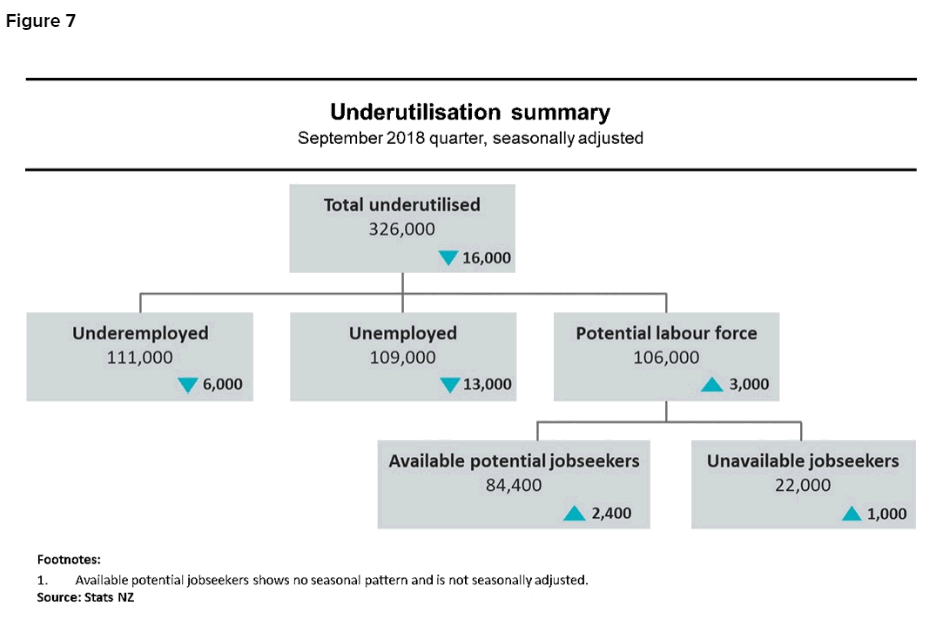
Text alternative for figure 7, Underutilisation summary, September 2018 quarter, seasonally adjusted
Thanks to the survey participants
We rely on people around New Zealand answering the HLFS survey every three months. Without your input, we wouldn’t be able to produce these data, which provide vital insights into the New Zealand economy and participation in the labour market.
So, if you have previously taken part in the survey or are selected in the future – thank you very much for your time and effort.
Text alternatives
Text alternative text for figure 1,
Working-age population summary, September 2018 quarter,
seasonally adjusted
Diagram showing the two main
components of the working-age population – people who are
in the labour force, and people who are not in the labour
force. In September 2018, the working-age population
consisted of 3,900,000 people – an increase of 15,000
people since June. The labour force consisted of 2,772,000
people - an increase of 16,000 people since June. There were
1,128,000 people who were not in the labour force, which was
1,000 fewer people than in June.
Text alternative for figure 2, Labour
force summary, September 2018 quarter, seasonally
adjusted
Diagram showing the two main components
of people who are in the labour force – employed and
unemployed. In the September 2018 quarter, the number of
employed people was 2,663,000, which had increased by 29,000
since the June 2018 quarter. At the same time, the number of
unemployed people was 109,000 people, which had fallen by
13,000 since the June 2018 quarter.
Text alternative for figure 5,
Unadjusted unemployment rates (95 percent confidence
intervals), September 2008 to September 2018 quarters,
September 2018 quarter, seasonally adjusted
A
line graph time-series of the unadjusted unemployment rate
from the September 1998 quarter to the September 2018
quarter. It has a light yellow shaded area around the main
time series, which illustrates the 95 percent confidence
intervals. We are 95 percent certain that the true value
lies within the yellow shaded area.
Text alternative for figure 6,
Unadjusted unemployment rates, September 2008 to September
2018 quarters
Column graph showing the
unadjusted unemployment rate from September 1998 to
September 2018. On each column, the error bars have been
added in brown. The error bars illustrate the 95 percent
confidence intervals, between which we are 95 percent
certain that the true figure lies.
Text alternative for figure 7,
Underutilisation summary, September 2018 quarter, seasonally
adjusted
Diagram showing a summary of the
components of underutilisation – underemployed people,
unemployed people, available potential jobseekers, and
unavailable jobseekers. In the September 2018 quarter, there
were 326,000 underutilised people, which was 16,000 fewer
people than in the June 2018 quarter. The number of
underemployed people was 111,000 people, down by 6,000 from
the June 2018 quarter. The number of unemployed people was
109,000 people, down by 13,000 in the June 2018 quarter. The
number of available potential jobseekers was 84,400, up
2,400 from the June 2018 quarter. The number of unavailable
jobseekers was 22,000, up 1,000 from the June 2018
quarter.
Ends
The Government Statistician authorises all statistics and data we publish.
For more information about these statistics:
• Visit Working-class heroes: Understanding labour market data


 Business Canterbury: Urges Council To Cut Costs, Not Ambition For City
Business Canterbury: Urges Council To Cut Costs, Not Ambition For City Wellington Airport: On Track For Net Zero Emissions By 2028
Wellington Airport: On Track For Net Zero Emissions By 2028 Landcare Research: ANZAC Gall Fly Release Promises Natural Solution To Weed Threat
Landcare Research: ANZAC Gall Fly Release Promises Natural Solution To Weed Threat NZ Anti-Vivisection Society: Auckland Rat Lovers Unite!
NZ Anti-Vivisection Society: Auckland Rat Lovers Unite! University of Canterbury: $1.35 Million Grant To Study Lion-like Jumping Spiders
University of Canterbury: $1.35 Million Grant To Study Lion-like Jumping Spiders Federated Farmers: Government Ends War On Farming
Federated Farmers: Government Ends War On Farming



